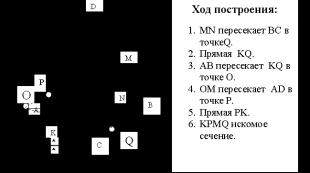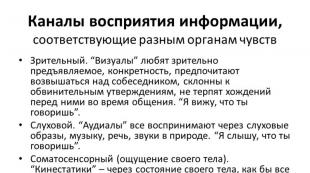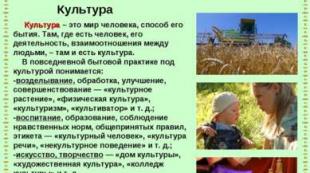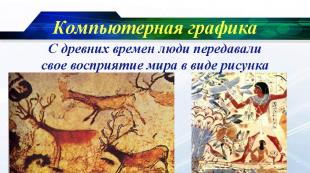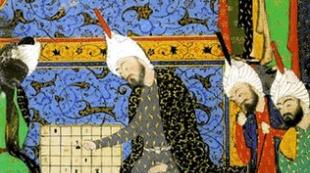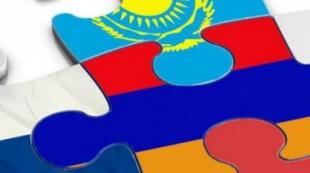Who is Murzilka? This question is often asked by children. Isami answers who calls a chicken, a bear cub, a dog, who is closer to someone Who created Murzilka
Few people know that the magazine owes its existence to the Canadian artist and writer Palmer Cox. At the end of the 19th century, he published a series of poems about the small people of the Brownies. And a little later, the Russian writer Anna Khvolson, inspired by the works of Cox, created her own series of stories, where the main character was Murzilka - a little man in a tailcoat and with a monocle.
In 1908, its popularity was quite large, and the editors of the publication “Dusushevnoe Slovo” began to publish a supplement - the newspaper “Murzilka Magazine”.
In the twenties, this publication turned into an independent magazine, but it was necessary to abandon the “bourgeois” image of the main character. Murzilka turned into an ordinary puppy with a good-natured smile, living with Petya and understanding the world. He flew in a hot air balloon, traveled with pioneers, slept in the same cage with a polar bear, etc.
In the thirties, thanks to the artist Aminadav Kanevsky, Murzilka acquired the image in which he has survived to this day, although somewhat modified - a yellow puppy in a red beret, a striped scarf, with a postman's bag and a camera.
At the end of the thirties, Murzilka disappeared from the pages of the publication and appeared only during the war years in the form. The magazine called for help in the military cause, talked about exploits and much more. When the war ended, the familiar yellow puppy returned again. At this time, S. Marshak, S. Mikhalkov, V. Bianki, K. Paustovsky, M. Prishvin, E. Schwartz and others began to be published on the pages of the publication.
During the Thaw period, the magazine's circulation grew to crazy numbers - about five million copies were published. Along with this, talented authors appeared - A. Barto, V. Dragunsky, Y. Kazakov, A. Nekrasov, V. Astafiev, etc. In addition, educational material began to appear in the magazine - the heading “Our Favorite Artists”, a section on travel “ Following the sun”, etc.
In the seventies, thematic issues dedicated to rivers, fairy tales and other areas began to be published. Works by foreign authors also began to appear - Otfried Preusler, Donald Bissetga, Astrid Lindgren, Tove Jansson.
During perestroika, a competent editor, Tatyana Filippovna Androsenko, began to manage the magazines. It was thanks to her that the publication did not sink into obscurity. The circulation fell, printing houses refused to print it, but all these problems were solved. New authors even began to appear.
Currently, “Murzilka” is a modern glossy publication that has not deviated from its traditions - the search for new young talented authors, high quality products, educational and entertaining materials for younger schoolchildren.
I often see the word “Murzilka” used in Internet slang. And you’ve probably heard it more than once with a modern meaning. What does it mean now? An offensive version of the word “virtual”? Please clarify in the comments...
In the meantime, we’ll talk about the history and origin of this word.
Story Murzilki began in 1879, when Canadian artist Palmer Cox created a series of drawings about Brownies - these are the closest relatives of brownies, small people, about 90 centimeters tall, similar to little elves with brown unkempt hair and bright blue eyes (because of the brown color of their hair they are called “brownies”). Their skin is predominantly light, although the color of a brownie's skin depends on where they live and what they eat. These creatures come at night and finish what the servants did not finish. But this was just a test before the real creation of those images that would later win over the public. So in 1881, exactly those same brownies appeared in the magazine “Wide Awake”, which began a triumphant march, first across America, and then throughout the world.
In February 1883, Cox began publishing in the New York children's publication St. Nicholas" pictures from brownie, accompanied by poems about the adventures of the heroes. And four years later, the first book “The Brownies, Their Book” was published, which contained a collection of stories about brownies and which sold a million copies. In total, Palmer Cox created 15 original brownie books before his death in 1924.
By the way, Cox’s brownies did not have names as such - they were called by characteristic nicknames, such as Chinese, Sailor, Dandy, Jockey, Russian, Hindu, King, Student, Policeman, Canadian, etc.
Murzilka and his friends first appeared on the pages of the magazine “Sincere Word” in 1887 in the fairy tale “A boy as big as a finger, a girl as big as a nail.” The author of this tale was the famous writer Anna Borisovna Khvolson, and the illustrations were drawings by the artist Palmer Cox.
The first edition of the book “The Kingdom of Little Ones,” including 27 stories and 182 drawings, was published in 1889, followed by reprints in 1898, 1902 and 1915.
In 1913, a book with drawings by Palmer Cox and Russian text from Anna Khvolson “New Murzilka. Amazing adventures and wanderings of little forest people." Anna Khvolson made a free translation of Cox's texts, giving the characters other names: Maz-Permaz, Dedko-Borodach, Znayka, Dunno, clever Skok, hunter Mick, Vertushka, Chinese Chi-ka-chi, Indian Ski, Mikrobka, American John, etc. P. Well, actually Murzilka, on whose behalf the story was told.
And it turned out that Murzilka impossibly similar to the famous Nosovsky Dunno. He is the same braggart, lazy and troublemaker, who, because of his character, constantly gets into various troubles. However, these two heroes also have differences. Murzilka, for example, a real dandy. A tailcoat or long coat, a top hat, boots with narrow toes, a cane and a monocle are indispensable components of his everyday costume.
So Dunno’s predilection for defiantly bright colors in clothes would have unpleasantly struck Murzilka’s refined taste. But this difference is purely external. Although the character Murzilki or, as his friends call him, “Empty Head” is quite similar to the character of his literary descendant; Dunno is written out in much more detail and volume. And if Khvolson’s hero is deliberately caricatured and conventional, then Nosov’s is a lively, charming and recognizable boy. Therefore, probably, over the careless and boastful Murzilka readers just laugh, but they often sympathize with Dunno, sincerely pity and love him.
So, the name Murzilka was born in 1913. Two years later, Anna Khvelson released an independent work called “The Kingdom of Little Ones. Adventures Murzilki and the Woodland Men,” which was illustrated by the works of the same Palmer Cox, but since it was not included in the official Brownie bibliography, it can be considered a remake.
He was a boy in a black tailcoat, with a huge white flower in his buttonhole, in a silk top hat and long-toed boots that were fashionable at that time... And he always had an elegant cane and monocle in his hands. At the end of the 19th and beginning of the 20th centuries, these tales were very popular. Myself Murzilka, according to the plot of the fairy tale, he constantly found himself in some funny stories. But after the 1917 revolution, the book was no longer published, and everyone forgot about this hero.
Next time o Murzilka remembered in 1924, when a new children's magazine was created under the Rabochaya Gazeta. One of the founders remembered this name and it was accepted almost unanimously. But don’t put a brownie on the cover! That's why Murzilka became a red mongrel puppy who accompanied his owner, the boy Petka, everywhere. His friends also changed - now they were pioneers, Octobrists, as well as their parents. However, the puppy did not exist for long - he soon disappeared, and Petka subsequently disappeared from the pages of the magazine.
It is traditionally believed that a certain fluffy yellow creature was born into the world by the artist Aminadav Kanevsky at the request of the editors in 1937. However, back in the 50s Murzilka was a little man wearing an acorn hat on his head instead of a beret. He appeared like this in several cartoons, the latest of which is “ Murzilka on satellite" - was created in 1960. It was this beret that later became an indispensable attribute of Murzilka, when it turned yellow and overgrown.
Soon other heroes began to appear in this magazine - evil sorceress Yabeda-Koryabeda, talking cat Shunka, Magpie-Balabolka, Sportlendik and Ladybug. All these characters became the hosts of the main sections of the magazine - funny and entertaining stories, curiosity questions, a sports page, stories about nature.
The best children's writers were published on the pages of “Murzilka”: Samuil Marshak, Korney Chukovsky, Sergei Mikhalkov, Boris Zakhoder, Agnia Barto. The smallest Murzilka“instilled a love of learning with the help of bright pictures, interesting plots and playful poems.
In 1977 - 1983. The magazine published “A detective-mysterious story about Yabeda-Koryabeda and her 12 agents” (author and artist A. Semenov) and its continuations. Often the magazine took on topics that were far from children's. For kids who have only recently learned to read, “ Murzilka“talked about the conquest of space, the construction of the Dnieper Hydroelectric Power Station, the 1980 Olympics, and even explained the ideology of the party - “To the October Revolution about Communists.”
Magazine " Murzilka"is still published. It is listed in the Guinness Book of Records as the “longest-running children's magazine.”
Let's remember a few more answers to interesting questions: or here, and also no less interesting The original article is on the website InfoGlaz.rf Link to the article from which this copy was made -Agafurov Alfrid
This research work traces the entire history of the creation and origin of the main character of the children's magazine - Murzilka.
Download:
Preview:
STATE EDUCATIONAL INSTITUTION OF THE OMSK REGION
“TARA SPECIAL (CORRECTIONAL) SCHOOL – BOARDING FOR CHILDREN – ORPHANS AND CHILDREN WITHOUT PARENTAL CARE WITH LIMITED HEALTH CAPABILITIES VIII TYPE”
WORK THEME
Completed by: Agafurov Alfrid,
7th grade student
Head: Solovyova L.A.
Teacher
Tara - 2013
- Introduction – page 3
- Analysis of resultssurvey of class students – page 4
- Murzilka in ancient times - page 6
- Palmer Cox- "Brownie"- page 7
- Anna Borisovna Khvolson- stories about little forest people – page 8
- Murzilka - a small white dog with its owner - the boy Petya – page 9
- Murzilka - little man – page 10
- Aminadav Kanevsky- image of a puppy - correspondentMurzilki – page 11
- Book Alexandra Khvolson- “The kingdom of little ones. The Adventures of Murzilka and the Forest Men” - page 12
- "Murzilka" - magazine for children – page 13
- Special sectionsmagazine "Murzilka" - page. 14
- Guinness Book of Records– page 15
- Conclusions and offers - page 16
- Literature – page 17
Application questionnaire “Murzilka – who is he and where is he from?”
- Introduction.
From early childhood, every child has favorite toys and cartoon characters. Does the child know the history of the creation of these toys and cartoon characters? Where did they come from? Who invented them?
Purpose of the study– prove the story of origin and creation using a specific hero.
Research objectives:
- To identify the level of children’s knowledge about the history of the origin and creation of a particular hero.
- Trace the history of the origin and creation of a particular hero.
- Tell the story of the origin, creation, popularity of a particular hero.
- Analysis of survey results
class students.
In our century, children have completely different cartoon characters and hence the toys. And before there was the famous hero Murzilka, who was filmed in cartoons, fairy tales were written, and a children's magazine was published.
The survey method was used to determine how much the history of the origin and creation of Murzilka is known.
The students were asked to answer several questions. 24 students took part in the survey. Test results showed that most students do not know what animal Murzilka looks like, who created it and where it came from.
Summarizing the results obtained during testing are given in table 1.
Analysis of the results of a survey of class students
Question | Answer options | Number of selected answers |
Do you know who Murzilka is? | A. Alien. B. Fairy-tale hero. V. Forest dweller. S. I don’t know | |
Do you know what animal Murzilka looks like? | A. For a puppy. B. To Belchonka. B. To the teddy bear. S. I don’t know | |
Do you know who invented the hero Murzilka? | A. People's hero. B. Foreign writer. V. Soviet writer. S. I don’t know | |
Do you know where he came from? | A. From the forest. B. From the Moon. V. From a fairy tale. S. I don’t know. | |
Do you know whose relative Murzilka is? | A. Dogs. B. Santa Claus. V. Bear. S. I don’t know. | |
Have you read the magazine "Murzilka"? | A. Yes. B. No. | |
What sections do you like in this magazine? | "Art Gallery" “The Red Book” “Let’s have a heart-to-heart talk” “Travel and discovery.” |
- Murzilka in ancient times.
Who is Murzilka?- This question is often asked by children. And they themselves answer who calls him a chicken, a bear cub, a dog - who is closer to whom.
Murzilka - in ancient times they scared naughty children.
This small and very evil shaggy creature could sneak up on a naughty child and bite off his toes or do something worse.
The very word “Murzilka” came from murz. This is what they said about a dog that gets angry and growls, baring its teeth.
- Palmer Cox- cycle of poems about little people"Brownie".
At the end 19th centuryCanadianartist and writerPalmer Coxcame up with a series of poems with his own illustrations about little people"Brownie".
These are the closest relatives of brownies, small people, about 90 centimeters tall, similar to little elves with brown unkempt hair and bright blue eyes (because of the brown color of their hair they are called “brownies”). Their skin is predominantly light, although the color of a brownie's skin depends on where they live and what they eat. These creatures come at night and finish what the servants did not finish.
- Anna Borisovna Khvolson- stories about little forest people
A little later, a Russian writerAnna Borisovna KhvolsonBased on Cox's drawings, she wrote stories about little forest men, where the main character was Murzilka (the writer came up with the names herself).It was a boy in a black tailcoat, with a huge white flower in his buttonhole, wearing a silk top hat and long-toed boots that were fashionable at that time. And in his hands he always had an elegant cane and a monocle.
From Anna Khvolson, “Although his brothers loved Murzilka, they considered him a lazy person, which he really was. In addition, he loved to show off: he wore a long coat or tailcoat, a tall black hat, boots with narrow toes, a cane and a glass in his eye , which he was very proud of, while others called him Empty Head."
Murzilka himself, according to the plot of the fairy tale, constantly found himself in some funny stories.
- Murzilka - a small white dog with its owner - the boy Petya
Murzilka experienced several fateful changes in her life.
16th of May1924 V USSRThe first issue of the Murzilka magazine was published.
Now Murzilka was a small white dog and appeared together with his owner, the boy Petya. Murzilka was a dependent character, dependent on his master.
- Murzilka - little man
However, back in the 50s Murzilka was a little man wearing an acorn hat on his head instead of a beret. He appeared like this in several cartoons, the latest of which is"Murzilka on the satellite"– was created in 1960. It was this beret that later became an indispensable attribute of Murzilka.
- Aminadav Kanevsky- image of a puppy - correspondent Murzilki
IN 1937 artist Aminadav Kanevskycreated the image of a puppy that became famous in the USSR -correspondentMurzilki is a yellow fluffy character in a red beret, with a scarf and a camera over his shoulder.
From the biography Murzilka knows that he is the grandson of Father Frost and the snow woman. And as soon as he appears, the most incredible and amazing adventures immediately begin with him.
- Book Alexandra Khvolson- “The kingdom of little ones. The Adventures of Murzilka and the Forest Men."
IN 1993The publishing house "Kvesta" published a book under the authorship ofAlexandra Khvolson - “The kingdom of little ones. The Adventures of Murzilka and the Forest Men."
In the 21st century "Murzilka" - full-color glossy edition, magazine for children. Wherein magazine still preserves traditions, collecting on its pages only the best examples of modern Russian literature for children. Several sections about art, Russian history, nature, entertaining, educational, developmental tabs make the new “Murzilka” meaningful and interesting.
Murzilka has acquired a lot over the years friends and they became the hosts of the main sections of the magazine - funny and entertaining stories, curiosity questions, a sports page, stories about nature.
The best children's writers were published on the pages of Murzilka: Samuil Marshak, Korney Chukovsky, Sergei Mikhalkov, Boris Zakhoder, Agnia Barto.
Murzilka instills in her magazine love for learning with the help of bright pictures, interesting plots and playful poems.
- Special sectionsmagazine "Murzilka".
Jokes, riddles, fables, and games are published in Murzilka from issue to issue to this day, although in recent years they have become more frequent come up with The guys themselves are readers of the magazine, and our grown-up hero, Murzilka, now runs the letters department in the magazine, which is called “Murzilka Post Office.”
Special sections magazine: “Murzilki Art Gallery”, “Red Book of Murzilki”, “Let's Talk Heart to Heart”, “Travel and Discoveries”.
- Guinness Book of Records.
IN 2011the magazine "Murzilka" was listed V Guinness Book of Records.
It has been recognized as the longest running children's publication.
Noun, number of synonyms: 3 dirty (34) magazine (28) old topic (2) Dictionary of synonyms ... Synonym dictionary
MURZILKA- Hero and name of the children's magazine. For the first time, a character named Murzilka appeared in Russian children's literature at the end of the 19th century. in the fairy tale by A.B. Khvolson “The Kingdom of Little Ones. The Adventures of Murzilka and the Forest Men" with illustrations by the artist Palmer Cox... Linguistic and regional dictionary
Murzilka- little man, gnome, toy. Derived from Murza. [Wrong. This word is derived from Murz get angry, grumble (about a dog), dial., onomatopoeic, which Dahl mistakenly placed in the article Murza. - T.] … Etymological Dictionary of the Russian Language by Max Vasmer
Murzilka- (“Murzilka”), a children’s monthly magazine of the Komsomol Central Committee and the Central Council of the All-Union Pioneer Organization named after. V.I. Lenin. Published in Moscow since 1924. K. I. Chukovsky, S. Ya. Marshak, M. M. Prishvin, V. V. participated in the formation of the magazine. Great Soviet Encyclopedia
"Murzilka"- monthly literary and artistic magazine for children of preschool and primary school age, since 1924, Moscow. Founder (1998) Editorial staff... encyclopedic Dictionary
Murzilka- Murz ilka, and, husband... Russian spelling dictionary
Murzilka on satellite- Cartoon type hand-drawn Genre fantasy ... Wikipedia
Murzilka (magazine)- Murzilka Specialization: children's magazine Publication frequency: once a month Language: Russian Editor-in-Chief: Tatyana Androsenko Publisher (country): (Russia) Date of foundation: 1924 Volume... Wikipedia
Murzilka and the giant- Cartoon type hand-drawn... Wikipedia
Children's magazine "Murzilka"- Murzilka is a popular monthly children's literary and artistic magazine. Addressed to children from 6 to 12 years old. The first issue of the magazine was published on May 16, 1924, after which the publication was never interrupted. Until 1931, the magazine existed as... ... Encyclopedia of Newsmakers
Books
- Magazine "Murzilka". Annual file for 1958. "Murzilka" is a popular Soviet, then Russian monthly children's literary and art magazine. Published since May 16, 1924 and addressed to children of primary school age. For 90 years...
On May 16, 1924, the first issue of the Murzilka magazine was published in the Soviet Union, intended for children of primary school age - from 6 to 12 years old, which very quickly became a popular children's literary and artistic publication...
The history of Murzilka began in 1879, when the Canadian artist Palmer Cox created a series of drawings about Brownies - these are the closest relatives of brownies, small people, about 90 centimeters tall, similar to little elves with brown unkempt hair and bright colors. blue eyes (because of the brown color of their hair they are called “brownies”).
Their skin is predominantly light, although the color of a brownie's skin depends on where they live and what they eat. These creatures come at night and finish what the servants did not finish. But this was just a test before the real creation of those images that would later win over the public. So in 1881, exactly those same brownies appeared in the magazine “Wide Awake”, which began a triumphant march, first across America, and then throughout the world.

In February 1883, Cox began publishing in the New York children's publication St. Nicholas" pictures with brownies, accompanied by poems about the adventures of the heroes. And four years later, the first book “The Brownies, Their Book” was published, which contained a collection of stories about brownies and which sold a million copies. In total, Palmer Cox created 15 original brownie books before his death in 1924.
By the way, Cox’s brownies did not have names as such - they were called by characteristic nicknames, such as Chinese, Sailor, Dandy, Jockey, Russian, Hindu, King, Student, Policeman, Canadian, etc.
First Murzilka and his friends appeared on the pages of the magazine “Sincere Word” in 1887 in the fairy tale “A boy as big as a finger, a girl as big as a nail.” The author of this tale was the famous writer Anna Borisovna Khvolson, and the illustrations were drawings by the artist Palmer Cox. The first edition of the book “The Kingdom of Little Ones,” including 27 stories and 182 drawings, was published in 1889, followed by reprints in 1898, 1902 and 1915.
In 1913, a book with drawings by Palmer Cox and Russian text from Anna Khvolson “New Murzilka. Amazing adventures and wanderings of little forest people." Anna Khvolson made a free translation of Cox's texts, giving the characters other names: Maz-Permaz, Dedko-Borodach, Znayka, Dunno, clever Skok, hunter Mick, Vertushka, Chinese Chi-ka-chi, Indian Ski, Mikrobka, American John, etc. P. Well, actually Murzilka, on whose behalf the story was told.

And it turned out that Murzilka is incredibly similar to the well-known Nosovsky Dunno. He is the same braggart, lazy and troublemaker, who, because of his character, constantly gets into various troubles. However, these two heroes also have differences. Murzilka, for example, is a real dandy. A tailcoat or long coat, top hat, boots with narrow toes, a cane and a monocle are indispensable components of his everyday costume. So Dunno’s predilection for defiantly bright colors in clothes would have unpleasantly struck Murzilka’s refined taste.
But this difference is purely external. Although the character of Murzilka or, as his friends call him, “The Empty Head” is quite similar to the character of his literary descendant, Dunno is written out in much more detail and volume. And if Khvolson’s hero is deliberately caricatured and conventional, then Nosov’s is a lively, charming and recognizable boy. Therefore, probably, readers only laugh at the careless and boastful Murzilka, but they often sympathize with Dunno, sincerely pity and love him.
So the name Murzilka born in 1913. Two years later, Anna Khvelson released an independent work called “The Kingdom of Little Ones. The Adventures of Murzilka and the Forest Men,” which was illustrated by the works of the same Palmer Cox, but since it was not included in the official Brownie bibliography, it can be considered a remake.
He was a boy in a black tailcoat, with a huge white flower in his buttonhole, in a silk top hat and long-toed boots that were fashionable at that time... And he always had an elegant cane and monocle in his hands. At the end of the 19th and beginning of the 20th centuries, these tales were very popular. Murzilka himself, according to the plot of the fairy tale, constantly found himself in some funny stories. But after the revolution of 1917, the book was no longer published, and everyone forgot about this hero...

Next time o Murzilka remembered in 1924, when a new children's magazine was created under the Rabochaya Gazeta. One of the founders remembered this name and it was accepted almost unanimously. But don’t put a brownie on the cover! Therefore, Murzilka became a red mongrel puppy who accompanied his owner, the boy Petka, everywhere.
His friends also changed - now they were pioneers, Octobrists, as well as their parents. However, the puppy did not exist for long - he soon disappeared, and Petka subsequently disappeared from the pages of the magazine.
It is traditionally believed that a certain fluffy yellow creature was born into the world by the artist Aminadav Kanevsky at the request of the editors in 1937. However, back in the 50s, Murzilka was a small man wearing an acorn hat on his head instead of a beret. He appeared like this in several cartoons, the last of which, “Murzilka on Sputnik,” was created in 1960. It was this beret that later became an indispensable attribute of Murzilka, when it turned yellow and overgrown.

Soon other heroes began to appear in this magazine - the evil sorceress Yabeda-Koryabeda, the talking cat Shunka, Magpie-Balabolka, Sportlendik and Ladybug. All these characters became the hosts of the main sections of the magazine - funny and entertaining stories, curiosity questions, a sports page, stories about nature.
The best children's writers were published on the pages of “Murzilka”: Samuil Marshak, Korney Chukovsky, Sergei Mikhalkov, Boris Zakhoder, Agnia Barto. “Murzilka” instilled in the little ones a love of learning with the help of bright pictures, interesting plots and playful rhymes.
In 1977 - 1983. The magazine published “A detective-mysterious story about Yabeda-Koryabeda and her 12 agents” (author and artist A. Semenov) and its continuations. Often the magazine took on topics that were far from children's. For kids who had only recently learned to read, “Murzilka” talked about the conquest of space, the construction of the Dnieper Hydroelectric Power Station, the 1980 Olympics, and even explained the ideology of the party - “To the Octobrists about Communists.”

The magazine "Murzilka" is still published. In 2011, it was listed in the Guinness Book of Records as the "longest-running children's magazine." Over the many years of existence of the beloved children's magazine, its publication has never been interrupted.
The modern “Murzilka” is a full-color glossy publication, as before, full of interesting, educational materials on topics that attract not only young readers, but also their parents. With a variety of topics and interesting presentation, the magazine strives to satisfy the ever-growing demands of its readers. Many materials are not only informational in nature, encourage creativity, but also develop useful skills. Materials are also printed here to supplement the primary school curriculum.
“Murzilka” is a mirror of our children's literature. After all, he still preserves traditions, collecting on his pages only the best examples of modern Russian literature for children. The magazine is published once a month, with a circulation of 60,000 copies.


